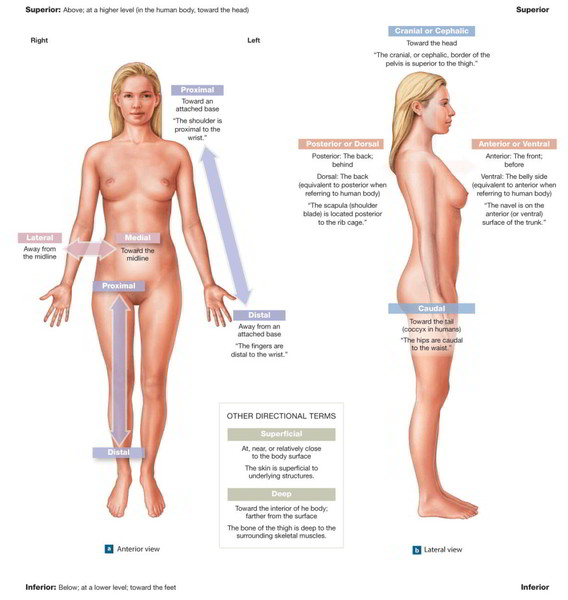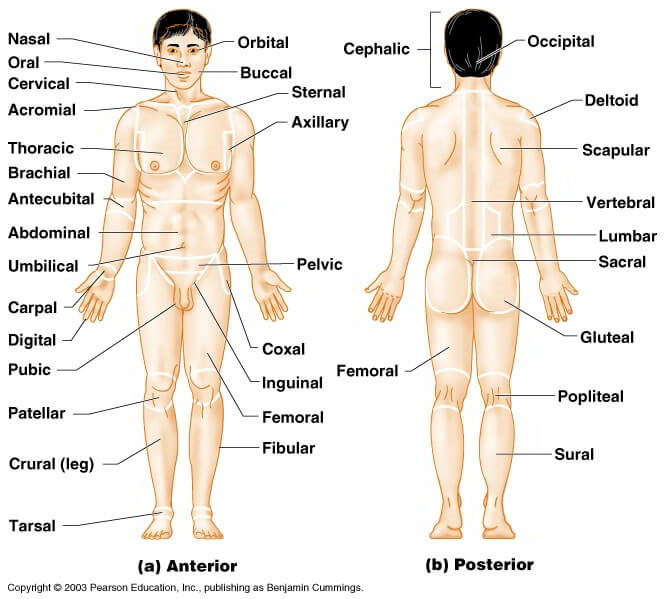Directional terms are used to describe the relationship of one part of the body to another. Various body parts and their relationship with other body parts can be easily understood by the usage of Directional terms in anatomy. Readers have the ease to analyze the anatomical position of the body parts with these directional terms.
It is the fact that the standard anatomical position of the body is to stand straight with front facing palms of the hands & upper limbs at the side.
The image below explains various directional terms of anatomy in the simplest manner.

Directional Terms for Anatomical Position
Most of the directional terms used to describe the relationship of one part of the body to another can be grouped into pairs that have opposite meanings. For example, superior means toward the upper part of the body, and inferior means toward the lower part of the body.
It is important to understand that directional terms have relative meanings, they make sense only when used to describe the position of one structure relative to another. For example, your knee is superior to your ankle, even though both are located in the inferior half of the body.
Study the directional terms below and the example of how each is used. As you read the examples, look at Figure above to see the location of each structure.
Directional Terms in Human Anatomy
| Term | Meaning | Examples of Usage |
| Ventral | Toward the front* or belly | The aorta is ventral to the vertebral column. |
| Dorsal | Toward the back or spine | The vertebral column is dorsal to the aorta. |
| Anterior | Toward the ventral side* | The sternum is anterior to the heart. |
| Posterior | Toward the dorsal side* | The esophagus is posterior to the trachea. |
| Cephalic | Toward the head or superior end | The cephalic end of the embryonic neural tube develops into the brain. |
| Rostral | Toward the forehead or nose | The forebrain is rostral to the brainstem. |
| Caudal | Toward the tail or inferior end | The spinal cord is caudal to the brain. |
| Superior | Above | The heart is superior to the diaphragm. |
| Inferior | Below | The liver is inferior to the diaphragm. |
| Medial | Toward the median plane | The heart is medial to the lungs. |
| Lateral | Away from the median plane | The eyes are lateral to the nose. |
| Proximal | Closer to the point of attachment or origin | The elbow is proximal to the wrist. |
| Distal | Farther from the point of attachment or origin | The fingernails are at the distal ends of the fingers. |
| Superficial | Closer to the body surface | The skin is superficial to the muscles. |
| Deep | Farther from the body surface | The bones are deep to the muscles. |
The human body consists of an axial portion, the head, neck, and trunk, and an appendicular portion, the upper and lower limbs and their girdles. Each of these major portions of the body is divided into regions with special names to facilitate communication and to aid in locating body components.

Major Body Regions
Major Regions of the Head, Neck, and Trunk
| Region | |||
| Head and Neck | Anterior Trunk | Posterior Trunk | Lateral Trunk |
| Buccal | Abdominal | Dorsum | Axillary |
| Cephalic | Abdominopelvic | Gluteal | Coxal |
| Cervical | Inguinal | Lumbar | Inferior Trunk |
| Cranial | Pectoral | Sacral | Genital |
| Facial | Pelvic | Vertebral | Perineal |
| Nasal | Sternal | ||
| Oral | Umbilical | ||
| Orbital | |||
| Otic | |||
Major Regions of the Limbs
| Region | ||
| Upper Limb | Digital | Femoral |
| Antebrachial | Olecranal | Patellar |
| Antecubital | Palmar (pal’-mar) | Pedal |
| Brachial | Lower Limb | Plantar |
| Carpal | Crural | Popliteal |
| Deltoid | Digital | Sural |

 (58 votes, average: 4.78 out of 5)
(58 votes, average: 4.78 out of 5)